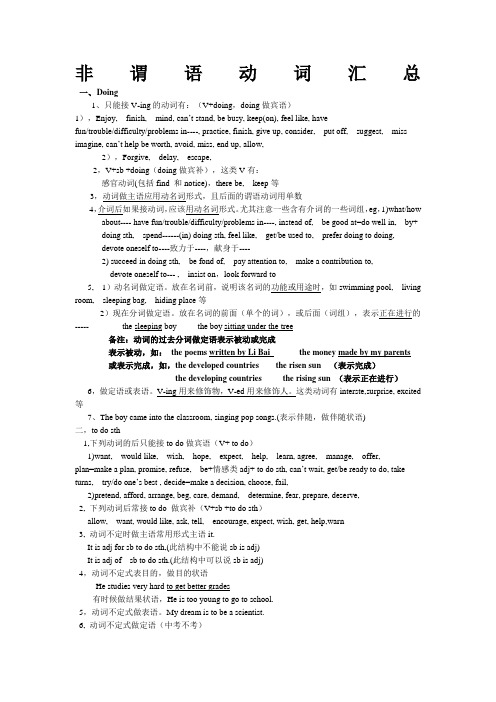[动词非谓语形式]非谓语动词的用法总结
- 格式:doc
- 大小:17.00 KB
- 文档页数:6


非谓语动词三大形式非谓语动词是英语中一种特殊的动词形式,在句子中作不同的语法功能。
非谓语动词有三种形式:动词不定式、动名词和分词。
在本文中,我们将介绍这三种形式的用法以及它们在句子中的不同作用。
一、动词不定式动词不定式是动词的一种非谓语形式,由“to + 动词原形”构成。
在句子中,动词不定式可以作多种语法功能,如主语、宾语、表语、宾补等。
1. 作主语动词不定式可以作为句子的主语,常常用于表达一种观点、信念或建议。
例如:•To learn a new language takes time and effort.(学习一门新语言需要时间和努力。
)•To travel is to live.(旅行就是生活。
)2. 作宾语动词不定式可以作为及物动词的宾语,常常用于表示目的、意图或动作的结果。
例如:•I want to visit Paris.(我想去巴黎。
)•She loves to read books.(她喜欢阅读书籍。
)3. 作表语动词不定式可以作为系动词的表语,常常用于描述主语的特征、性质或状态。
例如:•Her dream is to become a doctor.(她的梦想是成为一名医生。
)•The key to happiness is to live in the present.(快乐的钥匙是活在当下。
)4. 作宾补动词不定式可以作为及物动词的宾补,常常用于补充说明及物动词的意义。
例如:•She made me laugh.(她让我笑了。
)•They consider him to be the best candidate.(他们认为他是最佳候选人。
)二、动名词动名词是动词的一种非谓语形式,以-ing结尾。
在句子中,动名词可以作多种语法功能,如主语、宾语、表语、宾补等。
1. 作主语动名词可以作为句子的主语,常常用于表示一种习惯、经验或普遍情况。
例如:•Running helps to keep me fit.(跑步有助于保持健康。

非谓语动词的用法总结动词不定式(一) 时态1. 一般式动词不定式的一般式表示与谓语动词同时或之后的行为。
如: I want to have a restI plan to attend the meeting 2. 完成式不定式的完成式表示不定式的动作发生在谓语动词所表示的动作之前的行为。
如:I ’m sorry to have kept you waiting. 3进展式不定式的动作假如同谓语动词所表示的动作同时发生那么使用不定式的进展式。
如: They seemed to be talking about something important. 4. 完成进展式不定式的完成进展式表示在谓语动词之前已经发生,并且一直进展着的动作。
如: He is said to have been working in that factory for twelve years. 〔二〕动词不定式用法:1. 作主语To master English gives us much help in the study of science 2. 作宾语I want to leave here soon. He pretended to be a doctor. 3. 作表语The most important thing is to study hard. 4. 作宾语补足语不定式作定语必须放在被修饰的名词或代词的后面。
I have no time to talk with her. 6. 作状语不定式作状语时可以表示目的、原因、结果或条件。
I came here to learn from you ( 目的) I ’m very glad to heard the news。
〔原因〕 He is old enough to go to school.(结果) To look at him ,you can’t help laughing.Notes:7. 不定式的复合构造。


非谓语动词汇总一、D oing1、只能接V-ing的动词有:(V+doing,doing做宾语)1),Enjoy, finish, mind, can’t stand, be busy, keep(on), feel like, havefun/trouble/difficulty/problems in----, practice, finish, give up, consider, put off, suggest, miss imagine, can’t help be worth, avoid, miss, end up, allow,2),Forgive, delay, escape,2,V+sb +doing(doing做宾补),这类V有:感官动词(包括find 和notice),there be, keep等3,动词做主语应用动名词形式,且后面的谓语动词用单数4,介词后如果接动词,应该用动名词形式。
尤其注意一些含有介词的一些词组,eg,1)what/how about---- have fun/trouble/difficulty/problems in----, instead of, be good at=do well in, by+ doing sth, spend------(in) doing sth, feel like, get/be used to, prefer doing to doing,devote oneself to----致力于----,献身于----2) succeed in doing sth, be fond of, pay attention to, make a contribution to,devote oneself to--- , insist on,look forward to5, 1)动名词做定语。
放在名词前,说明该名词的功能或用途时,如swimming pool, living room, sleeping bag, hiding place等2)现在分词做定语。

非谓语动词用法总结非谓语动词是指动词的非谓语形式,一般包括动词不定式、动名词和分词(包括现在分词和过去分词)。
非谓语动词有着特定的用法和功能,能够在句子中充当主语、宾语、表语、定语或状语等成分。
下面将对非谓语动词的用法做一个总结。
一、动词不定式(to + 动词原形)1. 作主语:To learn is important for everyone.学习对每个人来说都很重要。
2. 作宾语:I want to go shopping.我想去购物。
3. 作表语:His dream is to become a doctor.他的梦想是成为一名医生。
4. 作定语:The best way to learn English is to practice speaking.学习英语的最佳方法就是练习口语。
5. 作状语:She went to the library to borrow some books.她去图书馆借些书。
二、动名词(Ving形式)1. 作主语:Swimming is good for health.游泳对健康有好处。
2. 作宾语:I enjoy reading novels in my free time.我喜欢在空闲时间读小说。
3. 作表语:Her favorite hobby is drawing.她最喜欢的爱好是画画。
4. 作定语:I saw a man reading a newspaper in the park.我看到一个在公园里读报纸的人。
5. 作状语:She improved her English by practicing every day.她通过每天练习提高了她的英语。
三、分词(普通形式:Ving形式或者过去分词形式)1. 作定语:The smiling girl is my sister.那个笑着的女孩是我的妹妹。
2. 作补语:I saw him running in the race.我看到他在比赛中奔跑。
高中英语非谓语动词用法小结非谓语动词是指不与主语保持一致的动词形式,包括不定式、动名词和分词。
在英语语法中,非谓语动词在句子中扮演着重要的角色,它可以作为主语、宾语、定语和状语等,并且有着特定的用法规则。
下面我们将对非谓语动词的用法进行小结。
一、不定式(Infinitive)1. 不定式的构成和用法不定式的构成是由“to + 动词原形”组成,例如:to go,to play等。
不定式在句子中可以作为主语、宾语、定语和状语,例如:(1)主语:To learn English well is important.(学好英语很重要)(2)宾语:I like to read books.(我喜欢读书)(3)定语:The book to read is on the desk.(要读的书在桌子上)(4)状语:He came to visit me yesterday.(昨天他来看我了)2. 特殊不定式的用法2.1 带to和不带to的不定式有些动词后面可以接带to和不带to的不定式,但意义不同。
例如:(1)forget to do sth.忘记做某事;forget doing sth.忘记做过某事(2)remember to do sth.记得做某事;remember doing sth.记得做过某事2.2 在形容词后使用不定式在某些特定的形容词后使用不定式,如:happy to do sth.,sorry to hear that.二、动名词(Gerund)三、分词(Participle)四、总结非谓语动词在英语中的用法非常灵活,需要根据具体的语境来确定。
掌握非谓语动词的用法不仅能够丰富句子的表达方式,还能够在写作和口语中提升语言的表达能力。
学生在学习英语的过程中,应该注重非谓语动词的规则和用法,多加练习,提高语言能力,从而更好地应对各种语言环境。
非谓语动词用法概要非谓语动词指动词不定式、Ving 和Ved形式。
请看下表(以动词do为例):一.非谓语动词基本形式主动被动一般式完成式一般式完成式不定式to do to have done to be done to have been done Ving形式doing having done being done having been doneVed形式××done ×二.非谓语动词均不能在句中单独作谓语,但可以作句子的其他成分。
请看下表:非谓语动词主语宾语宾补定语状语不定式√√√√√Ving形式√√√√√Ved形式××√√√三.非谓语动词具体在句中用法(一)作主语时1.不定式作主语表示一个未来的、具体的动作。
To readize your aim is not easy if you don't work hard.假如你不努力工作,实现目标是不易的。
2.动名词做主语表示一般的、经常性的动作。
Speaking English is very important for English study,so to speak English every day is necessary.英语口语对英语学习是非常重要的,因此有必要每天都练一练英语口语。
I like swimming but I don't like to swim today.我(平时)喜欢游泳,可是今天不想去游泳。
(二)作宾语时(和作主语是含义类似)1.下列动词和短语后面只能接不定式:agree, ask, arrange, choose, determine, dare, agree, demand, expect,elect, fail, hope, long, manage, offer, plan, promise, pretend, refuse, seem, want, wish, should / would like / love2.下列动词和短语后面只能接V ing形式admit, avoid, delay, enjoy, escape, excuse, finish, imagine, keep(on), mind, miss, practise, suggest, be / become / get used to, be worth, devote oneself to, feel like, get down to, give up, insist on, look forward to, prefer...to...,put off, etc.3.下列动词和短语后面接不定式或V ing形式都可以,但是意义有所不同:forget, go on, mean, remember, regret, stop, try, etc.4.need, require, want三个动词都有相同的意思,也有两种相同的用法——主语是动作的承受者时,宾语可以是V ing形式,也可以是不定式的被动式。
非谓语动词总结【2篇】非谓语动词在英语中很常见,关于非谓语动词的语法知识自然就要大家能够熟练掌握。
下面是小编整理的2篇《非谓语动词总结》,可以帮助到您,就是小编我最大的乐趣哦。
非谓语动词总结篇一一、非谓语动词的概念动词的基本用法是作谓语。
当句中已经有了谓语动词了,要选或要填的动词就只能用非谓语形式了。
非谓语形式有三种:1、动词不定式:to do2、动词的ing : doing3、动词的过去分词:done二、三种形式的含义(基本用法)不定式:表示目的和将来;动词的ing:表示主动和进行;过去分词:表示被动和完成。
三、非谓语动词的否定形式在非谓语动词前加not, never. 即not / never to do, not / never doing四、非谓语动词的复合结构不定式的'复合结构:for / of sb. to do sth.动词ing 形式的复合结构:宾格或所有格+doing (-ing 形式作主语时,用的所有格+doing)五、非谓语动词的做题步骤1、判定是否用非谓语形式。
方法:看看句子中是否已有了谓语动词了2、找非谓语动词的逻辑主语。
方法:非谓语动词的逻辑主语一般是句子的主语。
3、判断主被动关系。
方法:非谓语动词与其逻辑主语的主动还是被动关系。
4、判断时间关系。
方法:分析句子,看看非谓语动词所表示的动作发生在谓语动作之前、之后还是同时。
之前常用done; 之后常用to do; 同时常用doing.学习非谓语形式时,建议把三种形式一起来比较学习,会更加有效一些。
一、非谓语动词作主语和表语的比较1、不定式和动名词作主语和表语a. 不定式表示一次性的、具体的动词。
动词ing 常表示一般的、泛指的或习惯性的动作。
如:________ is a good form of exercise for both young and old.A. The walkB. WalkingC. To walkD. Walk(分析)a good form 暗示泛指一般的行为,用动名词作主语,选Bb. 不定式作主语时,常用it 作形式主语,即用句型:It is + adj. / n. + (for / of sb. )to do sth.It’s important for us to learn English well.It’s kind of you to help us.注意:下面几个句型是用动名词:It’s no good / use doing sth.It’s useless doing sth.There is no need to do sth.2、不定式、动名词、分词作表语的比较1、不定式、动名词作表语,。
非谓语动词的分类及用法总结非谓语动词是指不具备谓语功能的动词形式,包括不定式、动名词和分词。
它们在句中作不同的成分,具有丰富的用法和特点。
本文将对非谓语动词的分类及其用法进行总结。
一、不定式(Infinitive)不定式是动词的一种非限定形式,具有名词、形容词和副词的特点。
不定式一般由动词原形加上“to”构成,也有少数动词不加“to”。
分类:1. 基本不定式:- 例句:I want to go to the movies tonight.(我今晚想去看电影)2. 省略to的不定式:- 例句:Let me help you.(让我来帮你)3. 完全不定式(动词+不定式符号to):- 例句:I want you to listen to me.(我希望你听我说)用法:1.作主语:- 例句:To learn a foreign language requires patience.(学习外语需要耐心)2.作宾语:- 例句:I like to play tennis.(我喜欢打网球)3.作宾语补足语:- 例句:He made her cry. (他使她哭了)4.作定语:- 例句:I have a lot of work to do.(我有很多工作要做)5.作状语:- 例句:He came to borrow some money.(他来借些钱)二、动名词(Gerund)动名词是动词的一种非限定形式,具有名词特点,一般以动词原形加上“-ing”构成。
分类:1. 一般动名词:- 例句:Walking helps keep you healthy.(散步有助于保持健康)2. 所有格形式动名词:- 例句:I appreciate his helping me.(我感激他帮助我)用法:1.作主语:- 例句:Swimming is good for you.(游泳对你有好处)2.作宾语:- 例句:I enjoy reading books.(我喜欢读书)3.作宾语补足语:- 例句:I heard him singing in the shower.(我听见他在洗澡时唱歌)4.作定语:- 例句:She likes playing the piano.(她喜欢弹钢琴)5.作状语:- 例句:He learned English by watching movies.(他通过看电影学英语)三、分词(Participle)分词是动词的一种非限定形式,具有形容词和副词的特点,一般以动词原形加上“-ing”或“-ed”构成。
[动词非谓语形式]非谓语动词的用法总结
动词不定式
时态
1、一般式
动词不定式的一般式表示与谓语动词同时或之后的行为。
如:
I want to have a rest
I plan to attend the meeting
2、完成式
不定式的完成式表示不定式的动作发生在谓语动词所表示的动作之前的行为。
如:
I ’m sorry to have kept you waiting、3进行式
不定式的动作如果同谓语动词所表示的动作同时发生则使用不定式的进行式。
如:
They seemed to be talking about something important、
4、完成进行式
不定式的完成进行式表示在谓语动词之前已经发生,并且一直进行着的动作。
如:
He is said to have been working in that factory for twelve years、动词不定式用法:
1、作主语
To master English gives us much help in the study of science
2、作宾语
I want to leave here soon、 He pretended to be a doctor、
3、作表语
The most important thing is to study hard、
4、作宾语补足语
不定式作定语必须放在被修饰的名词或代词的后面。
I have no time to talk with her、
6、作状语
不定式作状语时可以表示目的、原因、结果或条件。
I came here to learn from you I ’m very glad to heard the news。
H e is old enough to go to school、 To look at
him ,you can’t help laughing、
Notes:
7、不定式的复合结构。
如:I found it hard for them to finish the work in such a short time、 It was clever of him to find his way here、
分词
闲着分词与过去分词的区别:
1、现在分词表主动;过去分词表被动:Burning forest; burned skin
2、现在分词表示动作正在进行;而过去分词表示的动作已完成:eg: developing country;
developed country
分词担当的句子成分
定语 eg: They decided to change the material used
状语分词常用来作状语,表示时间、原因、方式、结果、条件、让步和伴随情况。
分词作状语,它的逻辑主语应与句子的主语保持一致。
Relying on our own efforts , we can overcome all the difficulties Hearing the news, they all jumped with joy The teacher walked about the classroom, using his hands to help him in his explanation The child fell, striking his head against the door and cutting it The students went out of the school, laughing and talking Given better attention, the trees could grow better、
为了表示明确的时间或条件,有时刻在分词前加上
when;while;if 等连词 When leaving the airport, she waved again and again to us、 While waiting for the train, I had a long talk with her、
If translated word by word, the sentence will be meaningless、
分词有时也可以有自己独立的逻辑主语,分词独立主格结构,在很多情况下,表示时间、原因、条件或伴随情况Weather permitting, the football match will be played on Wednesday We went far into the forest, her father acting as guide、
So many people being absent, we decided to put the meeting off、
3、表语
The news is exciting ; She looked disappointed
4、宾语补足语
Don ’t you see him coming towards us
现在分词的完成形式主要用在状语中,表示的动作在谓语动作之前发生。
H aving finished his homework, the boy began to watch Tv 被动式
现在分词的被动形式不仅表示被动的动作,而且表示这个动作正在进行;或这个动作与谓语动词的动作同时发生。
现在分词的被动形式主要作定语、状语和宾语补足语。
T he pidge being built there will be one of the longest in China Being surrounded ,the enemy were forced to put down their guns 完成被动式
Having been given such a good chance, how could she give it up、
动名词
用法:
1、主语:Reading aloud is very important in learning
a foreign language、
2、表语 Their job is building houses
3、宾语 I enjoy seeing you and talking about old times
Need, want 后面的动名词具有被动意义。
E g: Your suit needs ironing
4、定语
动名词表示的多是被修饰的名词的功能、用途。
E g: walking stick; walking tractor、
Children enjoy reading picture-story books I apologize for not having kept my promise、She didn’t mind being left alone at home
动名词的逻辑主语:
动名词可以用物主代词或名词所有格来修饰,表示动名词逻辑上的主语。
Do you mind my making a suggestion? 但在非正式英语中,尤其是当动名词在句子中作宾语时,更常见的是用人称代词宾格和普通格的名词修饰动名词
Do you mind me making a suggestion?
I ’m pleased with John pay his income tax in time、。